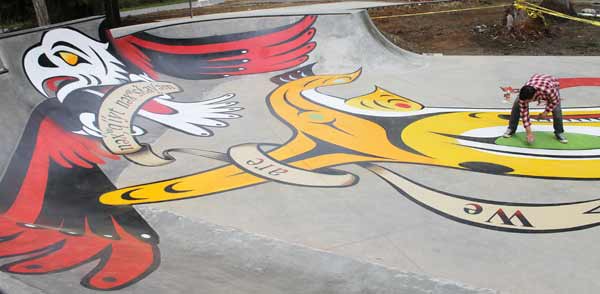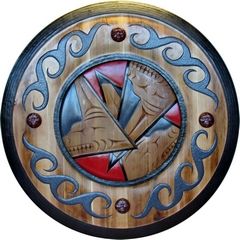
By Kipp Roberston, North Kitsap Herald
Editor’s note: This version expands a comment in the 20th paragraph to clarify how the skatepark and the art will be a mechanism for sharing S’Klallam culture.
LITTLE BOSTON — It was almost midday at the Port Gamble S’Klallam skatepark, and Louie Gong and Josh Wisniewski were preparing to put some final touches on the art sprayed onto the cement.
The two were discussing the collaboration that resulted in a skatepark that was more than a place for people to skateboard. Then, the sound of wings overhead as an eagle flew above, almost directly over a Coast Salish painting of an eagle.
Maybe the eagle was a sign. “Or not, maybe. Maybe [it] just is,” said Wisniewski, the Tribe’s archeologist and cultural anthropologist.
The Tribe will celebrate the official opening of the skatepark in April. It’s a project that started in 2012, after the project was chosen as the best skatepark project — from hundreds of submissions — via social media through the Sheckler Foundation.
The foundation, founded by professional skateboarder Ryan Sheckler, assists projects that benefit and enrich the lives of children and injured athletes. It was the foundation’s first project.
The Tribe provided the site for the project, near the Teekalet neighborhood. The site was selected by the S’Klallams Working and Giving (SWAG) youth group.
After the site was selected, Angelique Zaki of the foundation visited Little Boston to help plan the skatepark’s development. She connected the Tribe’s planning department with Grindline Skateparks, a skatepark developer in Seattle which has built more than 120 parks — from Okinawa, Japan, to Orcas Island to Oxford, Miss. Grindline donated its design services, Zaki said.
Other project partners: Map Ltd., construction and civil engineers of Silverdale, surveying services; Krazan & Associates of Poulsbo, soils testing; and Coho Concrete of Kingston, concrete laying.
Gong said he received a grant through the Evergreen Longhouse to help with costs, mainly travel between his home and the Port Gamble S’Klallam reservation.
The skatepark has become more than just another place to skate. It reflects the Tribe’s youth and culture.
“The artwork here in the park is really meant to reflect the people and interest of who the park belongs to,” Gong said.
Gong, an artist of Nooksack and Chinese ancestry, was one of the driving forces behind the skatepark art. Gong produces Coast Salish art in various forms — among them shoes, skateboard decks and home decor — for his company, Eighth Generation. He was contacted by Wisniewski and invited to participate.
Gong worked with SWAG on what art they would like to see at the park. He took that info back to his office in Seattle and made mockups of the designs and potential color templates on his computer.
Gong and S’Klallam youth then used high-end spray paint, with stencils and masking tape at times, to piece together the art.
The art project was mostly completed within March. The result is a colorful and cultural skating experience.
Breaking barriers
When a non-tribal member steps onto the skatepark they will see an eagle, orca, canoe, and two phrases written in S’Klallam: “It becomes new,” and “We are Noo-Kayet S’Klallam.” “It becomes new” is the closest language equivalent to “Be the Change,” the Sheckler Foundation’s campaign.
It’s almost like a stamp. “You walk into that park, and the first thing you see is ‘Port Gamble S’Klallam,’ ” Wisniewski said.
The artwork was a way to reflect the youth — not only as S’Klallam, but as the people who brought the skatepark into the community, he said. And that’s not being done in an exclusionary way, but as a way to show respect for the youths’ hard work.
“People have perceptions of Native people and communities,” Wisniewski said. “This park is something that kids who are Tribal members can invite their off-reservation friends to come visit. In doing so and sharing the park and the art, they will be able to share their community, culture and language. That is how the park and skateboarding will break down barriers.”
Already a lot of interest in park
The skatepark is technically open to the S’Klallam community and guests. But that doesn’t mean there isn’t growing interest in the park from outside of the community.
As boxes of spray paint cans and stencils were being pulled out of a supply shed so a few more artistic features could be added to the park, two men pulled into the adjacent parking lot. They wanted to know when the park would be open. Because painting was going on, they were turned away.
Apparently, interested skaters have become common at the park, which hasn’t officially opened.
Wisniewski said skateboarding is growing in popularity within Native American communities. A “cultural event,” he called it.
The skatepark will also give S’Klallam youth another recreational opportunity. Other than the skatepark, there is a playground, gym and basketball court. There is not a lot of recreation for older kids in Little Boston, Wisniewski said.
“If you don’t have a place for kids to do stuff, they won’t do it,” he said.
When finished, the S’Klallam skatepark will be one of four skateparks in the area. Other skateparks are located in Kingston, at Raab Park in Poulsbo, and at Clear Creek Park in Silverdale.


